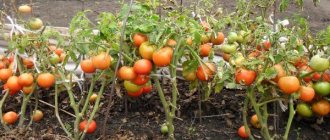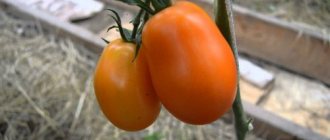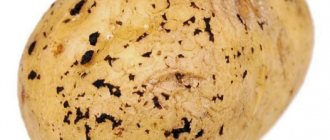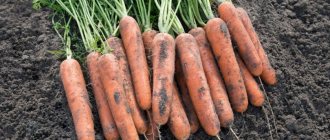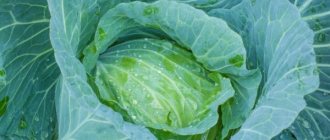Description of carrot variety Children's sweetness
Children's sweetness belongs to the mid-early varieties . Sowing is carried out in late April - early May. Carrots can withstand temperatures as low as -4°C. Ripening period is 110-130 days. Root vegetables are rich orange in color, sweet, juicy and crunchy. The variety has high yields - 286-371 c/ha.
The variety can be sown before winter . Sowing is carried out after the temperature drops to +5°C, usually in late October - early November.
The variety is used for preparing children's juices and purees .
Other "children's" varieties
Breeders have developed many sweet varieties of carrots. One of them is carrots Children's joy . She grows smaller than Sweetness, but they have the same taste.
The Children's variety is mid-season with a high content of vitamins PP, C, E, K, B, A. The harvest is sweet and juicy root vegetables with a small core.
Children's vitamin is a mid-season variety. Recommended for fresh use and winter storage. Weight of root crops 95-130 g.
Sweet tooth is one of the best sweet varieties, late-ripening, ripening period - 4 months. Contains an increased amount of saccharides and provitamin A.
Origin and development
The carrot variety Children's Sweetness was created by breeders based on the Amsterdam variety.
It is part of annual plants of the Berlicum variety , which produce root crops during one season. When planting root crops for the second season, active growth will occur only in the tops, followed by flowering and ripening of the seed material.
Chemical composition and beneficial properties
100 g of raw carrots contain : fructose - 12%, dry matter - 12.7-14.1%, beta-carotene - 20.8 mg. The energy value of one root vegetable is 34.5 kcal.
Content of macroelements in root vegetables (per 100 g):
- potassium – 225 mg;
- calcium – 24.6 mg;
- phosphorus – 52 mg;
- magnesium – 37.4 mg;
- sodium – 18.4 mg;
- sulfur – 4.5 mg.
Content of microelements (per 100 g):
- iron – 0.76 mg;
- zinc – 0.37 mg;
- aluminum – 0.36 mg;
- manganese – 0.22 mg;
- boron – 0.23 mg;
- vanadium – 0.13 mg;
- copper – 0.72 mg;
- fluorine – 0.5 mg;
- molybdenum – 0.22 mg.
Vitamins included (per 100 g):
- A – 0.97 mg;
- B1 – 0.07 mg;
- B2 – 0.07 mg;
- B8 – 0.32 mg;
- B9 – 0.12 mg;
- C – 0.7 mg;
- RR – 1.24 mg;
- E – 0.93 mg.
Root vegetables contain a high content of carotene - provitamin A. In children's bodies, it affects the growth and strengthening of bones, teeth, hair, and promotes skin health. The vitamins contained in carrots improve immunity and increase resistance to various infections.
Features of application
Carrots Children's sweetness is one of the sweetest varieties . Due to its excellent taste, it is widely used in baby food in the form of bunched products, freshly squeezed juices, and purees. Widely used in cooking for preparing various vegetable stews, soups, and salads.
Ripening period
Children's sweetness belongs to the mid-season varieties. The period from emergence to full ripeness is 110-130 days.
Productivity
Children's sweetness is characterized by high yield rates : 4.5-6.8 kg of carrots are obtained from 1 m². In some areas with favorable growing conditions, yields reach 7.5 kg per m².
Disease resistance
Pre-sowing seed treatment, soil disinfection after harvesting vegetables and in the spring before sowing can increase the resistance of the variety to many diseases and damage from insect pests. It is not particularly resistant to certain diseases .
Characteristics, description of appearance, taste
Root vegetables of the Children's Sweet variety are bright orange in color, the core has a red-orange hue . The shape is cylindrical, with a rounded tip, weight - 100-140 g, length 12-18 cm. The rosette of the variety is semi-spreading, the tops are strong.
The variety has excellent taste, root vegetables with a high sugar content, crispy . Carrots contain a high content of provitamin A. Due to their juiciness, the variety is widely used for making freshly squeezed juices.
For which regions is it best suited and what are the climate requirements?
The variety is recommended for cultivation in the Central Black Earth region of the country . Grows well in Voronezh, Belgorod, Lipetsk, Kursk, Tambov regions.
A temperate climate with a warm summer season and long frost-free periods during the winter for growing the variety and preserving its properties
Children's joy
The carrot variety Children's Joy belongs to the mid-season group. It is grown for up to 130 days to obtain ripe and juicy fruits. The root color is red. The core is thin. The pulp is sweet and aromatic. The variety attracts with its large fruits and high yield:
| № | Helpful information |
| 1 | carrots Children's Joy grows up to 25 cm in length. The fruit is smooth, cylindrical in shape, with a blunt end. Diameter 3-4 cm |
| 2 | bush is lush and spreading. When sowing, up to 7 cm is left between seedlings, 30-35 cm between furrows. The tops shade the soil, but they should not be cut off. This will disrupt the metabolic processes in the root crop |
| 3 | root weight 200-300 g |
| 4 | the yield in open ground is 8 kg/m2. Gardeners leave good reviews about baby carrots on forums |
| 5 | They grow crops not only in an open garden, but also in a greenhouse. This is important for gardeners in the northern and Siberian regions |
| 6 | frost-resistant variety. Sowing is carried out in late autumn, when frosts begin, or in early spring, when you can start working in the garden |
| 7 | the optimal temperature for seed ripening is 3 C. For the development of root crops, a higher temperature regime of 23 C is required |
| 8 | grow carrots in fertile, soft soils |
| 9 | The variety is not prone to bolting and flowering. Breeders protected it from diseases and pests |
More on the topic: How to care for Red Cor carrots?
Proper watering is important for root crops. Seedlings are not watered. They are covered with film. A greenhouse effect is created underneath it. The film must be removed daily to remove excess moisture and accumulated gases. Watering begins when seedlings emerge from the soil.
Igor Nikolaev
auto RU
Use a watering can so as not to wash out the roots. The liquid must be heated and filtered. Volume 6 l/m2. Watering schedule is once every 2 weeks.
After the first thinning, the volume of water is increased to 10 liters. After the second thinning, there should be up to 15 liters per 1 m2. 3 weeks before harvest, soil moisture is stopped. If you continue to water the carrots, the concentration of sugar and carotene in it will be reduced.
The main advantages and disadvantages of the variety
The variety is characterized as:
- high-yielding;
- resistant to stemming;
- having excellent taste and commercial qualities;
- easy to care for;
- resistant to temperature drops down to -4°C;
- differs from other sweet varieties by a longer shelf life.
Disadvantages of the variety:
- demands on soil fertility;
- dependence of taste on the illumination of the area;
- the need for periodic hilling.
What is the difference from other varieties
Children's sweetness differs from other varieties of crops :
- higher levels of sugar and carotene;
- to maintain high levels of sugar and carotene, the variety requires constant good lighting;
- The variety grows well only on fertile soils.
Features of planting and growing
The variety is unpretentious in care . Subject to the conditions of agricultural technology, a correctly selected plot of land with a suitable soil composition, you can obtain high yields.
When growing the variety in areas with a temperate climate, planting carrots before winter is allowed . With this growing method, the harvest is obtained 15-20 days earlier than with spring sowing.
Preparing for landing
Only fresh seeds are taken for sowing .
The germination rate of seed two or more years old will be low. The seeds are pre-sorted, removing light, immature and damaged specimens. The remaining ones are soaked for 2 hours in warm water . Empty, unusable seeds floating on the surface are discarded. The specimens that have sunk to the bottom of the container are removed and disinfected: a 3% hydrogen peroxide solution is heated to 40°C and the seed material is dipped into it for 15 minutes.
Then the seeds are germinated , wrapped in a cloth moistened with a solution of wood ash (1 teaspoon of ash per 1 liter of water). After this they are ready for sowing.
Attention! For pre-winter planting, the seeds are not germinated.
Soil requirements
Carrots are demanding on the quality and composition of the soil . To grow the variety, loose, fertile soil is required. If the site has clay soil, add peat and humus to it when digging. If the soil is heavy, sand is added to it. If the soil acidity is too high, dolomite flour is added by digging. The variety grows well on loamy soils.
The soil is prepared in the fall . All plant residues are removed, the soil is dug deep, and potassium and phosphorus fertilizers are added.
In the spring, before sowing, the area is loosened and dry wood ash is added.
Predecessors
When choosing a site for sowing carrots, particular importance is given to predecessors. legumes, grains, onions, garlic, cucumbers, potatoes, and tomatoes grew in this area last season You should not plant carrots after parsley, dill, fennel, parsnips, since these crops and carrots have common diseases and pests.
Reference. Carrots should not be planted in the same area for two or more years in a row.
Dates, scheme and rules of planting
Spring sowing is carried out in late April - early May , after the soil has warmed up to 8-10°C. In a pre-prepared area, make grooves 2 cm deep and water them with water. The seeds are laid out to a depth of 1.5-2 cm at a distance of 2 cm from each other. The grooves are sprinkled with a small layer of earth, slightly pressing it down. Leave a distance of 20 cm between rows.
When sowing before winter, planting is carried out in late October - early November , when the air temperature finally drops to 5°C.
Features of cultivation
To plant the variety, choose a sunny area with loose soil . It is necessary to take into account the depth of groundwater so that root crops are not in constant moisture.
Important! Overmoistening of the soil leads to the appearance of root rot.
Much attention is paid to constant loosening to prevent the formation of soil crust.
Carrots sown before winter emerge 2-3 weeks earlier than in spring, so watering, loosening, and fertilizing are also carried out earlier according to a scheme similar to spring.
Nuances of care
When growing the variety, it should be taken into account that Children's Sweetness grows well in sunny areas and does not tolerate even light shade. With slight darkening, the level of sugar and carotene in root vegetables decreases. In insufficiently lit areas, yields also decrease.
Interesting things on the site:
When is it time to collect carrot seeds and how to do it
How to make carrot seed oil and how to use it
Can you be allergic to carrots?
Watering mode
Before and when seedlings appear, the soil is moistened every 3 days . Watering is carried out in the morning with a small pressure of water so that the seeds are not washed out of the soil. As the plants grow, the abundance of watering is increased, while reducing their frequency to once a week. The soil should be moistened to a depth corresponding to the length of the root crops.
Important! Irrigation should be carried out regularly. Irregular watering at long intervals leads to cracking of root crops.
15-20 days before harvest .
Thinning and weed control
The first thinning is carried out when two pairs of leaves appear on the seedlings. Leave a distance of 2 cm between plants, removing undeveloped specimens. Then the procedure is repeated when the root crops reach a diameter of 1.5-2 cm. Ultimately, a distance of 5-6 cm should remain between the plants.
During thinning, weeds are removed , since their active growth retards the development of vegetables.
Attention! All removed weeds and root crops must be removed from the site after weeding and thinning, as they will attract pests.
Top dressing
3 weeks after the sprouts appear, the first fertilizing with urea is carried out: 20 g of the drug is diluted in 10 liters of water, watered at the root.
Important! Fertilizers are applied only to moist soil.
The second feeding is carried out 3 weeks after the first : potassium and phosphorus are added for the development of root crops. To do this, prepare a solution of 25 g of potassium nitrate, 30 g of “Superphosphate” and 10 liters of water. To feed the crop with potassium during the third procedure, use a solution of wood ash: 400 g per 10 liters.
Disease and pest control
The most common crop diseases:
- Fomoz - dry rot. Appears on the tops in the form of dry spots with a dark edge. The fungus then attacks the root crops. For prevention, phosphorus-potassium fertilizers are applied to the soil. Affected plants are treated with a solution of Rovral and Maxim.
- Alternaria - black rot. Yellow spots appear on the tops, leaves curl, and the fruits become covered with dry rot. At the first signs of damage, the plants are sprayed with the fungicide “Acrobat MC”: 20 g of the drug are dissolved in 5 liters of water.
- Rhizoctoniosis is a felt disease, recognized by the appearance of lead stains on root crops, leading to rotting of vegetables. Plants are watered with a solution of copper sulfate prepared at the rate of 100 g per 10 liters of water.
The main insect pest is carrot fly . When it appears, the leaves acquire a red-violet hue and curl. Fly larvae feed on root vegetables. To combat carrot flies, the drug “Inta-vir” is used: one tablet of the product is diluted in 10 liters of water, and the plant is sprayed. After 10 days, the treatment is repeated.
The mole cricket is also dangerous for baby carrots - it lives in the soil, feeding on root vegetables. The danger comes from adults and their larvae, which after birth actively destroy root crops. To combat the mole cricket, a composition is prepared from a tincture of mustard, pepper and alcohol.
Features of cultivation
The described variety, like many varieties of carrots that are grown in our territories, is unpretentious in care. But still, in order to get a good harvest, you will need to follow certain rules of agricultural technology, the description of which can be applied to other similar varieties.
Temperature
If you look at it from the perspective of gardeners, the growing process will not be difficult. Carrots themselves can withstand the cold well and sprout even with slight warming outside. To obtain an early harvest, it is practiced to sow carrots in the winter, as well as sow seeds in early spring.
Note! Young plants after entry can withstand short-term spring frosts well, reaching even -4 degrees. Prolonged cold temperatures will not affect the growth of the vegetable in any way.
The optimal temperature regime for growing vegetables is the range from 16 to 20. At too high temperatures, the growth of the root crop slows down, while active growth of foliage is activated. If, in addition to high temperatures, the soil is dry, then you may not get juicy root vegetables. If during the period of active growth the plant lacks moisture, the harvest will be not only small, but coarse and underdeveloped.
Additional Information. To obtain a good harvest, illumination is also important, but despite this, in Russia the vegetable is grown in regions with different day lengths.
Soil requirements
Carrots are the most demanding of soil characteristics. It will grow best on fertile, loose, permeable, weed-free soils. The best option would be land into which manure was applied as fertilizer a year or two ago. The plant reacts very poorly to fresh manure - the root crops will be branched, irregular in shape and have poor taste.
In acidic soils and with an excess of chlorine, root crops will have a lot of tails. If there is too much moisture, you won't get a good harvest; the carrots may crack badly.
Therefore, they approach soil preparation carefully and begin to take care of it in the fall. Before winter, the area reserved for carrots is dug up and all weeds and roots are removed. For deoxidation (if necessary), dolomite flour or lime is added to the soil, as well as potassium or phosphate fertilizers.
Important to consider! Carrots grow best if legumes, cabbage, cucumbers, tomatoes, onions and grains were planted in this place the previous year. You should not sow carrots after parsley, fennel, cumin, dill, carrots and parsnips.
In the spring, the prepared area is deeply loosened, supplied with complex fertilizer, and if possible, all stones and roots are removed. For sowing carrots, you should choose well-lit areas.
Sowing seeds
Before planting “Children's Sweetness” carrot seeds for permanent residence, they should be carefully prepared. As a rule, carrots have a relatively low germination rate compared to other crops (55-75%), and the seeds should not be stored for long, so it is better to choose the freshest ones.
Carrot shoots are not always friendly and appear late (you need to wait about three weeks)
The appearance of seeds is noted only on the 15-20th day, and is rarely amicable. To wash away essential oils from seeds, which prevent germination, it is best to pre-soak them. The seeds are transferred to fabric bags and immersed in water for a day at a temperature of about +30 degrees. The water should be changed every 3-4 hours. It is allowed to use a nutrient solution based on wood ash for soaking (a tablespoon is required for 2 liters).
Some people use other methods to harden and germinate seeds:
- Heat treatment with hot water;
- Sparging;
- Hardening with pre-soaking;
- Digging into the soil for several days before planting.
Growing carrots is carried out by simple sowing; growing seedlings is not used. If planting is carried out in the spring, then the seeds are sown in late April - early May. When sowing for winter, planting is done in late October - early November.
Due to the shape of the seeds, sowing carrots for children's sweetness is quite difficult. To avoid thickening, many gardeners use a little trick: mix seeds in equal proportions with sand.
Interesting to know. When sowing for the winter, the seeds should not be prepared; they are planted dry and more densely.
Spring sowing involves the use of prepared seeds; they are sown to a depth of 2 cm. About 15 cm is left between the rows. Mulching is carried out regularly. It is important to ensure that a crust does not form on the surface; it can slow down germination.
Watering
To get a good harvest, it is important to monitor soil moisture, since “Children's Sweetness” carrots do not like strong humidity, but even if there is a lack of it, it will not give the desired result. Before seedlings appear, water the beds 2 times a week, and then once every 7 days. It is recommended to stop watering the vegetable approximately 3 weeks before harvesting.
Watering is alternated with fertilizing. To ensure that nitrates do not accumulate in root crops by the time of harvesting, it is better to use organic compounds as fertilizers.
Thinning and loosening
Obtaining a good carrot harvest will be impossible without careful thinning. The first time it is carried out after 2-3 real leaves appear on the plant. A distance of 2-3 cm is left between individual plants. Then, if necessary, the procedure is repeated when the root crop reaches a diameter of about 2 cm. When thinning at this stage, a distance of about 5 cm should be maintained.
To get a good harvest, it is important to thin out in a timely manner.
Important! After thinning, all removed root crops must be removed from the garden bed, as they may attract carrot flies.
After each rain or artificial watering, it is important to loosen. Moreover, during this procedure it is recommended to perform a small hilling. This will prevent greening of the above-ground part of the root crop.
Harvest and storage
Harvesting begins in late August - early September . Winter carrots ripen earlier. The degree of maturity of root crops is judged by the beginning of drying of the lower leaves on the tops. Dry weather is chosen for harvesting. The collected vegetables are first sorted, dried, and then placed in winter storage.
How and when to collect
Vegetables are harvested in late summer - early autumn, at which time root crops stop growing.
The carrots are carefully lifted with a pitchfork and pulled out of the ground by the tops , shaken off the ground and transferred to a dry room to dry.
After that it is sorted. Undamaged, healthy specimens are selected for storage . Their tops are cut off and placed in winter storage. The rest goes for processing.
Storage features and keeping quality of the variety
The vegetable storage facility creates optimal conditions for long-term storage of crops. The air temperature must be maintained within 0...+5°C, humidity - 90-95% . Increased humidity leads to rotting of root crops. The room must be constantly ventilated.
With proper storage, the keeping quality of the variety reaches 95% .
Carrot pests
Like any vegetable, carrots have their enemies. The main pest is the carrot fly. It is easy to recognize its appearance - the leaves begin to curl.
The main reasons for the appearance of carrot flies:
- improper care;
- muffled landings;
- a large number of weeds;
- excessive watering and so on.
The main pest of carrots is the carrot fly.
To fight, you can use special drugs - Intavir, Actellix. If there are less than 30-35 days left before harvest, insecticide treatment is prohibited. Only manual removal of infected leaves will help here, and this is not too much joy, as it will take a lot of time. It is better to prevent the appearance of the pest by providing proper care.
Advice from experienced gardeners
Experienced summer residents do not recommend growing granulated seeds , since constant abundant watering is required to dissolve the granules. Gardeners note the low germination of such seeds.
Many summer residents mixing carrot seeds with sand in equal proportions before sowing to prevent plantings from becoming dense
Important! Experienced gardeners warn: you should not water the plants abundantly after a long break - this will lead to cracking of the fruits.
Reviews of the carrot variety Children's sweetness
There are only positive reviews about carrots Children's sweetness among gardeners and farmers.
Olga, Tula : “The salesperson in the store recommended the variety Children's Sweetness. I liked the description on the packaging. I decided to try it. The baby carrots grew up to be very tasty and sweet. Even my grandchildren liked it.”
Irina, Vladimir : “Children love to chew thin young carrots. A neighbor at the dacha shared the seeds of Children's Sweets. I really liked the taste: sweet, crispy. The kids really liked it."
Sergey, Omsk : “I am growing a variety of carrots, Children’s Sweetness, especially for my granddaughter. She loves to crunch on young sweet carrots in the summer. I liked the taste and shelf life.”

